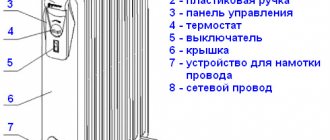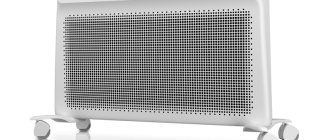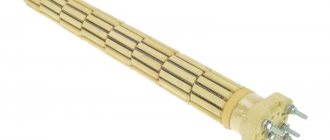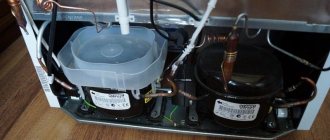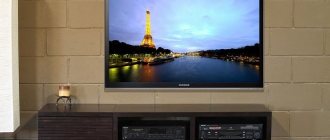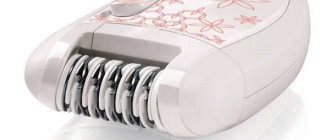Working principle of quartz slab
A quartz stove is an electric heater in the form of an embossed panel, sometimes with decorative elements. It works due to a heating coil, which heats up to a maximum temperature (sometimes it reaches 100 degrees!).
The heater, in turn, emits heat. Essentially, a quartz stove heats a room equally in two ways: infrared and convection. Infrared heating works like this: the heat that the device emits is absorbed by objects, and convection works so that the air moves from bottom to top, so it will be warmer at the top than near the floor.
Operating principle of a quartz heater
Although many different devices are now produced under the name “quartz heater”, not every one of them is a genuine quartz heater.
This phrase often means, for example, ordinary “heat guns” with built-in mineral elements that retain heat. A genuine quartz heater has the form of a monolithic slab, the material of which is a special mineral solution containing a lot of quartz. A conventional electric heater (TEH) made of nickel, which has a tubular structure, is built into this plate. When heated, this heater increases the temperature of the quartz plate, which transfers heat to the environment. They increase the temperature inside the room according to a scheme similar to the principle of operation of classic-type radiators or heat guns with passive convection. But the reason for the high demand for these devices is quartz.
Quartz has unique physical characteristics. A stove made from it heats up within 20 minutes, while it takes 1.5 hours to completely cool down. Therefore, even after being turned off, the quartz heater heats the room for some time. Also, due to the incandescent coil hidden in the mineral layer, it prevents the combustion of oxygen and drying of air.
The inside of a room in which a quartz heater is installed is as comfortable and warm as a room with a fireplace. The quartz device operates quietly and silently, does not burn oxygen and does not dry out the air, therefore it is optimal for long-term heating. In this regard, such a heater is much better than heat guns, convectors and radiators. After all, all these devices either make noise or reduce humidity, worsening the microclimate.
However, the main advantage that a quartz heater has is its modularity. 2 or more monolithic panels can be combined to form one heating system inside a room. In particular, one device, including a quartz plate measuring 61 by 34 cm and having a power of 0.5 kW, is enough to raise the temperature to a comfortable level in an area of 16 square meters. m in a room with a height of 2 to 3 m. In a larger room, it is possible to create a system of 3, 5 or more heaters.
Therefore, a quartz heater is ideal for any enclosed space - a country house, apartment, office, cottage, store, etc.
The best option is a quartz heater equipped with a thermostat. It turns off automatically after the set temperature level has been reached. It also turns on automatically when the indoor temperature drops. This ensures energy savings and creates a cozy microclimate inside the room.
Operating principle of an infrared heater
An infrared heater is a device that emits infrared waves, which are easily transmitted by air and absorbed by surfaces in the form of heat. Heat loss is minimal.
Infrared waves are divided into two types: long- and short-wave:
- Long-wavelengths have a beneficial effect on humans because they are identical to the rays of the Sun. They are emitted by devices that have a maximum heating temperature of up to 200 degrees.
- Short-wavelengths have a detrimental effect on human health and are dangerous. They are used in infrared heaters with heating temperatures of 800 degrees.
You can read more about the dangers of infrared heaters here: (link here).
Photos of QP series quartz emitters
Infrared emitters quartz electric QP series
Infrared emitters of the QP series are a block of tubular IR emitters in a special reflector. Such infrared emitters have dimensions that comply with international norms and standards, and therefore can replace ceramic infrared emitters in cases where a high speed heating process is required. Standard dimensions of IR emitters (mm): 248x62; 125x62; 62x62; 125x125.
Quartz infrared electric emitters of the QP series are made of quartz glass, inside of which a rheostatic wire is placed. For structural rigidity, the emitter is placed in a housing made of mirror-polished steel, which also serves as a reflector. This means that up to 95% of the infrared waves that come from the back wall of the heating part of the infrared emitter are reflected onto the heating object. And this significantly increases the efficiency of using the emitter.
See also:
The heating time of an electric infrared emitter to the maximum temperature is 20-30 seconds, so they are often used in cyclical and frequently interrupted work processes, where quick access to temperature conditions and rapid cooling after switching off are necessary. If necessary, electric infrared emitters can be manufactured with a “K” type thermocouple (NiCR-NiAl). Overall dimensions of infrared electric emitters QP comply with international standards.
Technical characteristics of quartz emitters.
Pros and cons of a quartz heater
Before you buy a product, you should familiarize yourself with its capabilities, advantages and disadvantages.
Let's start with the positives. These include:
- Silence.
- Relatively low cost.
- The device does not require the services of a specialist. Often the device comes with a special stand or holders on the wall; this is necessary for comfortable use of the device, and assembling the structure is not difficult, and the heater is ready for use immediately after connecting to the network.
- Does not dry out the air. This is an important factor for people with lung diseases or allergies.
- Economical use. The device works more economically than others in a small area.
Here are the main disadvantages of quartz heaters:
- Fragility. Unfortunately, such heaters are very thin (about 25 mm in thickness), so they can break from the slightest physical impact, not to mention the frequent cases when the device already had cracks when unpacking or was completely broken.
- Specific design.
- Heat. As we already said, the device heats up to temperatures over 100 degrees, which makes it dangerous if there are children or animals in the house.
- Inability to select a comfortable temperature range. Quartz heaters often do not have a thermostat, and if you want the device to heat up to a temperature that suits you, you need to purchase a thermostat and additional services from a specialist.
- Low power. Such devices cannot warm the room completely to the desired temperature, and are definitely not suitable as the main heating method. For a room measuring 18 square meters you will need at least 3 heaters!
Characteristics of a quartz heater
The monolithic quartz heating source has a special design that resembles a stove. The heating element is isolated from the environment because it is embedded in compressed sand . The plate of the device, which has increased heat transfer, retains heat for a long time due to its prolonged cooling.
The slab contains quartz sand, yellow quartz, and high-quality portlad cement. To make a heater that transfers heat well, nichrome is used, which is an alloy of nickel and chromium. This ensures high heat resistance of the heating element.
The power source of the device is an electrical network with a voltage of 220 volts . The standard dimensions of a device weighing no more than 10 kg are:
- Length - 61 cm.
- Height - 35 cm.
- Thickness - 2.5 cm.
The heating element of the heating source has a nominal positive power, which characterizes the moment of heat transfer from it to quartz, amounting to 0.5-0.7 kW . Heat in the same quantity enters the heating system from the network in 1 hour . The maximum heating of the apparatus plate has a temperature of 90–95°C . The source allows you to heat a room of 15 m2 to 32°C 30 minutes after the stove starts heating.
Advantages and disadvantages of an infrared heater
The advantageous features of an infrared heater are:
- Radiation. As we have already said, long-wave rays are perceived by humans and any living creatures as warmth, and create an atmosphere of comfort. In addition, the infrared heater can be used in a greenhouse.
- It also does not dry out the air.
- Heat radiation scheme that minimizes heat loss.
- Quick and easy to install.
- The system is immune to cold, and can be kept in the cold (for example, on a balcony, country house or in a country house), and then immediately begin working.
And here are the main disadvantages:
- Harmful to health. It is impossible to stay “warm” all the time from an infrared heater, as this causes dilation of the veins. You can read more about the dangers of infrared radiation here: (link here).
- Not suitable as main heating. And not only because of harm to health, but also because of economic disadvantage.
- No convection.
- Fast cooling. The device cools down immediately when disconnected from the network.
- High temperature of individual parts, which can lead to burns.
- Risk of fire.
Which heater is better, quartz or infrared?
To see the advantages of both types and evaluate which is better, consider the table:
| Parameter | Quartz | Infrared |
| Efficiency (efficiency) | less than 95% | more than 95% |
| To what temperature are surfaces heated? | up to 70°С | up to 90°С |
| The presence of a thermostat | There is | not always |
| Strength | high | low |
| Weight | easy | heavy |
| Energy consumption | below | higher |
| Repairability | easy to change spare parts | not being repaired |
| Fire safety | low | high |
| price | high | low |
Heating duration
The infrared heater heats up very quickly and heats objects in the room. The heat begins to be felt immediately after it is turned on. But quartz heats up much longer, gradually warming the air and objects at the same time. Therefore, you can quickly achieve comfort in a room using infrared.
Cost-effective and environmentally friendly
Both types of devices are environmentally friendly. They do not emit substances or radiation harmful to humans into the environment. Do not burn oxygen indoors. This compares favorably with halogen heaters, which were no longer used due to environmental damage.
It would be a misconception to believe that IR rays kill all living things, like ultraviolet radiation. In fact, they are on the opposite side of the spectrum.
Quartz ones will be more economical, because infrared ones consume more energy.
Comfort and safety
Ceramic heaters do not cause discomfort to residents of the house. The only thing you might not like is the clicking sound when the panels cool down and heat up. Many people also tolerate infrared rays well. But some people claim that after a long stay near the device they feel discomfort. Therefore, we can say that quartz ones are more comfortable to use. Although here, too, much depends on the individual characteristics of the person.
Manufacturers and prices
Of course, if you buy, you want to buy a durable and high-quality device. Here is a list of the most popular brands that meet these criteria:
- TepplEco. The company provides a 5-year warranty on purchased devices, and you can also buy additional accessories: protective film, thermostat and much more.
- TeploPlit. The products of this company, instead of 6-8, can heat 16-18 cubic meters, which is almost 3 times the efficiency of use.
- Centek. The peculiarity of this company’s product is that you can use both 50 and 100% power modes, which allows you to safely leave the device turned on in the countryside, and then you will be greeted with warmth and comfort.
In addition to the above advantages, these companies producing quartz heaters have a large number of positive reviews on the forums.
Recommendations for selection and operation
If you choose between quartz and infrared heaters, you should definitely choose the first one - although it has a number of disadvantages, such as a small heating area, this device is still cheaper and safe for health. But in some situations, an infrared heater will be better, for example, in the bathroom or in the hallway. If you want to use this device in your room, you will have to turn it away from you, which in principle does not affect the temperature of the room, because the heat is absorbed by the walls and radiated towards you.
Watch the video about which electric heater to choose
Advantages
The main advantage of a quartz infrared heater is its safety - the hot spiral and bulb are protected by a reflector and an additional grille. Other advantages include:
- high efficiency;
- energy saving;
- does not pollute or dry out the air;
- does not burn oxygen;
- long service life;
- wide price range;
- small dimensions of the device.
The heater quickly warms up a small room.
It will not cope so quickly with large rooms, but if necessary, the problem will be solved by installing an additional device. Buyers also choose a quartz infrared heater because being under infrared rays has the same relaxing effect as being under the sun's rays. See also –
Are infrared heaters harmful to health or not?
Results
The choice should be made depending on your home and preferences. If the room is large, an infrared device will handle heating better; if it is small, a quartz device will do the job. If you are in doubt, you can read the article about electric radiators - they will get the job done, are safe and easy to use.
If you liked the article, recommend us to your friends and save it for yourself. Subscribe to our blog! If you have any questions, ask us in the comments, we will definitely answer! See you again!
Sincerely, experts of the StroyDomEconom.RU portal!

